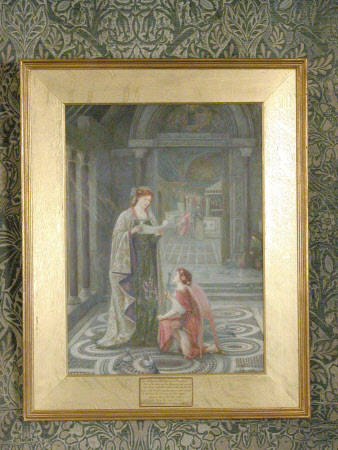Love and Mandetta of Toulouse
Marie Euphrosyne Spartali Stillman (Middlesex 1844 – London 1927)
Category
Art / Drawings and watercolours
Date
1903 (monogrammed and dated)
Materials
Watercolour and bodycolour on paper
Measurements
525 x 380 mm
Order this imageCollection
Wightwick Manor, West Midlands
NT 1287896
Summary
Watercolour and bodycolour, Love and Mandetta of Toulouse by Maria Spartali Stillman (Middlesex 1844 – London 1927), signed with monogram, dated 1903. The scene is referring to Mandetta of Toulouse, reading a scroll just received from kneeling messenger who holds a bow. Arched interior vista in background. This is a relatively late work by the artist. Narrative or dramatic scenes from literature, Dante, Boccaccio and other Italian poets, are dominant themes of Marie Spartali Stillman's work. Equally characteristic is the dense, opaque Pre-Raphaelite watercolour technique first developed by Rossetti and Burne-Jones, which she uses to create subtle colour harmonies. The subject is the verse inscribed on the frame: "Go, Balad to the city of Thoulouse, And softly entering the Daurade, look round And softly call, that so there may be found Some lady, who for compleasaunce may choose To show thee her who can my life confuse And if she yield thee way Lift thou thy voice and say "For grace I come to thee" It comes from Ballata, a poem by the 14th-century Italian author Guido Cavalcanti translated by D.G. Rossetti and published together with Dante's Vita Nuova in The Early Italian Poets, in 1861 (revised and republished in 1871 as Dante and his Circle). The building, an ancient church in Toulouse, was called the Daurade because of the golden (i.e. doree) effect of its mosaics.
Provenance
By descent to Chauncey Stillman (1907 – 1989) of 820 Fifth Avenue, New York; presented by him to National Trust at Wightwick Manor, around 1970
Marks and inscriptions
Go, Ballad to the city of even Toulouse,and softly entering the Daurade look round and softly call that there may be found some lady who for Compleasurance may choose To show thee her who can my life confuse (on plaque)
Makers and roles
Marie Euphrosyne Spartali Stillman (Middlesex 1844 – London 1927), publisher
